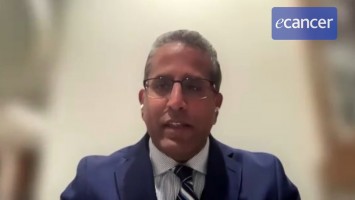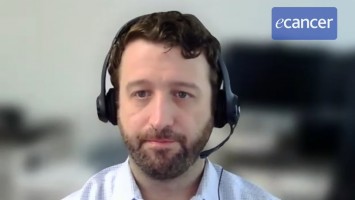ESTRO 2010, 12—16 September 2010, Barcelona
Interview with Professor Pierre-Yves Bondiau (Centre Antoine Lacassagne, Nice, France)
Cyberknife as a treatment for lung cancer
Tell us what you’ve been saying to people because it’s been really hot, hasn’t it?
Yes. I spoke about cyberknife because it’s a really new technology with a robotic arm with a linear accelerator to do the treatment of the lung tumour. They don’t only do lung tumours, we do the treatment of brain tumours, of spine tumours. The difference between conventional radiotherapy and the cyberknife is the accuracy of the beam delivery. We are less than 1mm so we can surround the spinal cord, for example, we can avoid the organ at risk, for example.
So this is the real difference between the conventional radiotherapy and the cyberknife. Another way to see this problem is when you have a lung tumour, the tumour is moving during the breathing, so the cyberknife is able to track the tumour during the breathing so you can avoid, again, the organ at risk or the rest of the lung.
How do you track a moving cancer in the lung?
Well it’s quite difficult but first we have to record the way to breathe of the patient and when we have recorded the way to breathe we can do an algorithm of the movement of the tumour during the breathing and we programme the robot with this algorithm so it can follow the tumour.
That’s really remarkable. And what about the imaging of this tumour? Do you image while you treat?
So we image each time we do a new beam. So we do nearly 150 beams on average and we do a new image for each beam or each two beams so we can be sure that the treatment, the beam delivery, is very accurate.
And how long does that take?
Well it’s quite long. First the positioning of the patient can be done in, let’s say, three minutes, three to ten minutes. And then when we start the treatment as the robot has to check for each beam where the tumour is, it can take more than one hour for the treatment.
And then how many treatments do you give?
For a day we deliver nearly eight treatments per day.
And per patient, how many treatments will I get for my lung cancer?
So eight treatments but for a treatment for lung cancer we do three fractions, so, for example, Monday, Thursday and Wednesday.
So you finish your treatment very quickly, in one week, and it’s very efficient.
Yes, so a rapid return to normal.
So where is it fitting in to the multidisciplinary management of lung cancer?
Well most of the patients are referred by the thoracic surgeon, radiation oncologist, medical oncologist or radiologist. Then we do a clinical case discussion about this patient and if the idea is to do surgery for T1 or T2 and zero, for example, and if the idea is to do surgery but for a medical problem that you can’t operate the patient, so the cyberknife is a good project to do.
And in N2 disease? T1 N2 for instance or T1 N1?
We treat for T1 and zero, T2 and zero and we have a research protocol for T1, T2, N2 that’s in the stage 3 lung cancer, we have a research protocol to do a boost with the cyberknife after the conclusion of radiotherapy.
And is that also after neo-adjuvant chemotherapy?
Yes. Yes, we do neo-adjuvant chemotherapy, radiotherapy with chemotherapy up to 44 Gray and then a boost with the cyberknife.
And then surgery, or not?
No surgery.
Not surgery, OK. And what’s the next step? What’s the next set of expectations with this tool?
So with this tool we treat lung, we treat spine and brain lesions. We have a research protocol for liver, for head and neck tumours, pancreatic tumour, bladder tumour and of course prostate tumour.
So it looks like being a very useful tool for the future?
Yes.
And is it possible to combine with chemotherapy or radiosensitizers or DNA repair blockers?
In fact, as you see, we do most of the treatment in one to five fractions, most of them are three fraction treatments. So there is no need really for radiosensitizers but we can do chemotherapy the same as if there was not treatment with the cyberknife because it’s very short treatment of the cyberknife.
Thank you very much indeed, that’s really interesting.








